
The London Marathon is an annual marathon held in London, England. It is the largest marathon in the world, with over 53,700 finishers in 2024, and 840,318 applicants for the 2025 event. Founded by athletes Chris Brasher and John Disley in 1981, it is typically held in April, although it moved to October for 2020, 2021, and 2022 due to the COVID-19 pandemic. The largely flat course is set around the River Thames, starting in Blackheath and finishing at The Mall. Hugh Brasher is the current race director and Nick Bitel its chief executive.
The timeline of underwater diving technology is a chronological list of notable events in the history of the development of underwater diving equipment. With the partial exception of breath-hold diving, the development of underwater diving capacity, scope, and popularity, has been closely linked to available technology, and the physiological constraints of the underwater environment.

Deep diving is underwater diving to a depth beyond the norm accepted by the associated community. In some cases this is a prescribed limit established by an authority, while in others it is associated with a level of certification or training, and it may vary depending on whether the diving is recreational, technical or commercial. Nitrogen narcosis becomes a hazard below 30 metres (98 ft) and hypoxic breathing gas is required below 60 metres (200 ft) to lessen the risk of oxygen toxicity.

Standard diving dress, also known as hard-hat or copper hat equipment, deep sea diving suit or heavy gear, is a type of diving suit that was formerly used for all relatively deep underwater work that required more than breath-hold duration, which included marine salvage, civil engineering, pearl shell diving and other commercial diving work, and similar naval diving applications. Standard diving dress has largely been superseded by lighter and more comfortable equipment.

A diving helmet is a rigid head enclosure with a breathing gas supply used in underwater diving. They are worn mainly by professional divers engaged in surface-supplied diving, though some models can be used with scuba equipment. The upper part of the helmet, known colloquially as the hat or bonnet, may be sealed directly to the diver using a neck dam, connected to a diving suit by a lower part, known as a breastplate, or corselet, depending on regional language preferences. or simply rest on the diver's shoulders, with an open bottom, for shallow water use.

Land's End to John o' Groats is the traversal of the length of the island of Great Britain between two extremities, in the southwest and northeast. The traditional distance by road is 874 miles (1,407 km) and takes most cyclists 10 to 14 days; the record for running the route is nine days. Off-road walkers typically walk about 1,200 miles (1,900 km) and take two or three months for the expedition. Signposts indicate the traditional distance at each end.

An aquanaut is any person who remains underwater, breathing at the ambient pressure for long enough for the concentration of the inert components of the breathing gas dissolved in the body tissues to reach equilibrium, in a state known as saturation. Usually this is done in an underwater habitat on the seafloor for a period equal to or greater than 24 continuous hours without returning to the surface. The term is often restricted to scientists and academics, though there were a group of military aquanauts during the SEALAB program. Commercial divers in similar circumstances are referred to as saturation divers. An aquanaut is distinct from a submariner, in that a submariner is confined to a moving underwater vehicle such as a submarine that holds the water pressure out. Aquanaut derives from the Latin word aqua ("water") plus the Greek nautes ("sailor"), by analogy to the similar construction "astronaut".

The JIM suit is an atmospheric diving suit (ADS), which is designed to maintain an interior pressure of one atmosphere despite exterior pressures, eliminating the majority of physiological dangers associated with deep diving. Because there is no need for special gas mixtures, nor is there danger of nitrogen narcosis or decompression sickness ; the occupant does not need to decompress when returning to the surface. It was invented in 1969 by Mike Humphrey and Mike Borrow, partners in the English firm Underwater Marine Equipment Ltd (UMEL), assisted by Joseph Salim Peress, whose Tritonia diving suit acted as their main inspiration. The suit was named after Jim Jarrett, Peress' chief diver.
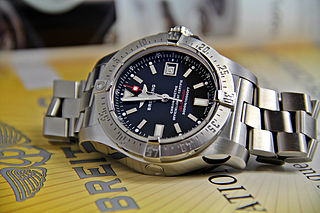
A diving watch, also commonly referred to as a diver's or dive watch, is a watch designed for underwater diving that features, as a minimum, a water resistance greater than 1.1 MPa (11 atm), the equivalent of 100 m (330 ft). The typical diver's watch will have a water resistance of around 200 to 300 m, though modern technology allows the creation of diving watches that can go much deeper. A true contemporary diver's watch is in accordance with the ISO 6425 standard, which defines test standards and features for watches suitable for diving with underwater breathing apparatus in depths of 100 m (330 ft) or more. Watches conforming to ISO 6425 are marked with the word DIVER'S to distinguish ISO 6425 conformant diving watches from watches that might not be suitable for actual scuba diving.
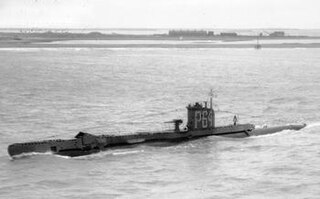
HMS Vandal (P64) was a Royal Navy U-class submarine built by Vickers-Armstrong at Barrow-in-Furness, yard number 838. The submarine had the shortest career of any Royal Navy submarine, being lost with all 37 onboard just four days after commissioning.
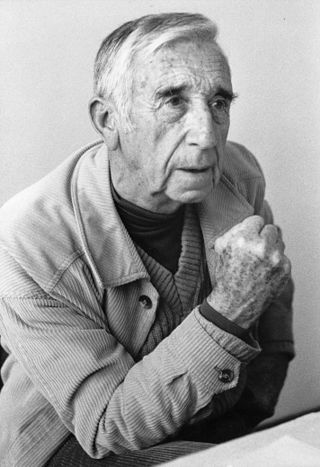
Philippe Tailliez was a friend and colleague of Jacques Cousteau. He was an underwater pioneer, who had been diving since the 1930s.
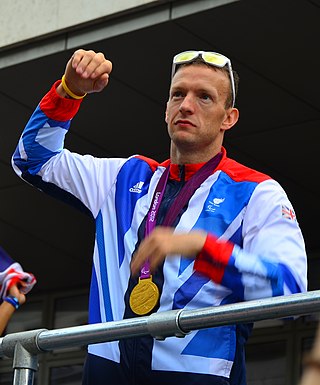
Richard Whitehead MBE is a British athlete. He runs with prosthetic legs, as he has a double through-knee congenital amputation.

Dave Heeley, a father-of-three from West Bromwich, who is nicknamed Blind Dave, is the first blind person to complete the seven-marathon challenge, doing so in 2008.
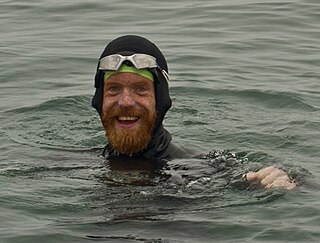
Sean Conway is a Zimbabwean ultra endurance athlete, author of 7 books and motivational speaker. He broke the world record for completing 105 Ironman triathlons in 105 days. He was the first person to swim the length of Britain, is the only person to have completed a length of Britain triathlon, has completed the world's longest triathlon of 4200 miles and has the world record for the fastest self supported cycle across Europe.
Rik Vercoe is a British ultramarathon runner from Walton on Thames, Surrey, England. In 2013 he set the British record for most marathons completed in 365 days, having run 152 races at marathon distance and above.
Dan Lawson is a British ultra runner and charity worker from Brighton. Lawson also does charity work in India for OSCAR India and Skillshare International. He holds the course record for the Grand Union Canal Race and in 2016, he won the European 24 Hour Championships, and in 2020 set one of the fastest known times for Land's End to John o' Groats (LEJOG).
Luke Robertson is a British and Scottish explorer, adventurer, endurance athlete and motivational speaker.
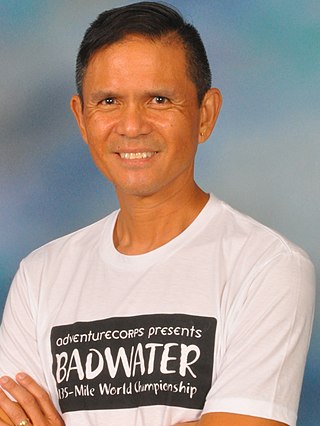
Gerald Tabios is a Filipino long-distance runner and Ultramarathon runner. Among his most notable races in the United States is the Badwater Ultramarathon. This is an annual race that stretches 135 miles through Death Valley, California in July and ends after a steep climb of Mount Whitney. In the world of Ultramarathons this race, where temperatures often reach 130 °F, is frequently coined "The Toughest Foot Race in the World." Tabios is a 7-time Badwater 135 finisher.

Ross Edgley is a British athlete, ultra-marathon sea swimmer and author. He holds multiple world records and is known for undertaking athletic adventures around the globe in some of the most hostile conditions ever recorded on earth. He is perhaps most recognised for completing the World's Longest Staged Sea Swim in 2018, when he became the first person in history to swim 1,780 miles (2,860 km) around Great Britain, in 157 days.















